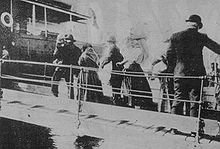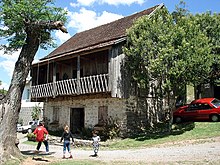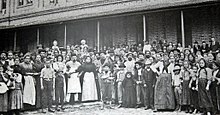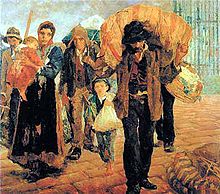Italian Brazilians: Difference between revisions
Undid vandalism 247569651 by Crazyaboutlost (talk) |
correcting |
||
| Line 19: | Line 19: | ||
Although victims of some prejudice in the first decades and in spite of the persecution during the [[Second World War]], Brazilians of Italian descent managed to mingle and to incorporate seamlessly into the Brazilian society. |
Although victims of some prejudice in the first decades and in spite of the persecution during the [[Second World War]], Brazilians of Italian descent managed to mingle and to incorporate seamlessly into the Brazilian society. |
||
Brazilians of Italian descent tend to be very participant in all aspects of Brazilian public life. Many Brazilian artists, footballers, models and personalities are or were of Italian descent. Also are or were of Italian descent, several States Governors, Congressmen, mayors and ambassadors. Three [[President of Brazil|Presidents of Brazil]] were of Italian descent: [[Pascoal Ranieri Mazzilli]], [[Itamar Franco]], and [[Emílio Garrastazu Médici]]. |
Brazilians of Italian descent tend to be very participant in all aspects of Brazilian public life. Many Brazilian artists, footballers, models and personalities are or were of Italian descent. Also are or were of Italian descent, several States Governors, Congressmen, mayors and ambassadors. Three [[President of Brazil|Presidents of Brazil]] were of Italian descent: [[Pascoal Ranieri Mazzilli]], [[Itamar Franco]], and dictator [[Emílio Garrastazu Médici]]. |
||
===Citizenship=== |
===Citizenship=== |
||
Revision as of 14:57, 25 October 2008

Italian immigrants in Brazil | |
| Regions with significant populations | |
|---|---|
| Brazil: Mainly Southern and Southeastern Brazil | |
| Languages | |
| Predominantly Portuguese. Some also speak Italian and/or Italian dialects | |
| Religion | |
| Predominantly Roman Catholic | |
| Related ethnic groups | |
| White Brazilian, Italian people |
An Italian Brazilian (Italian: Ítalo-Brasiliano, Portuguese: Ítalo-Brasileiro) is a Brazilian citizen of full or partial Italian ancestry. There are 28 million Brazilians of Italian descent, the largest population of Italian background outside of Italy itself.
Italians in Brazil

Italian Brazilians ethnicity in Brazil
Brazilians of Italian descent are the 4th most populous group of Brazilians, just behind the descendants of Portuguese settlers, descendants of African slaves, and Amerindians. Italian surnames are common among Brazilians since 28 million Brazilians have Italian ancestors.
Although victims of some prejudice in the first decades and in spite of the persecution during the Second World War, Brazilians of Italian descent managed to mingle and to incorporate seamlessly into the Brazilian society.
Brazilians of Italian descent tend to be very participant in all aspects of Brazilian public life. Many Brazilian artists, footballers, models and personalities are or were of Italian descent. Also are or were of Italian descent, several States Governors, Congressmen, mayors and ambassadors. Three Presidents of Brazil were of Italian descent: Pascoal Ranieri Mazzilli, Itamar Franco, and dictator Emílio Garrastazu Médici.
Citizenship
According to the Brazilian Constitution, anyone born in Brazil is a Brazilian citizen by birthright. In addition, many who were born in Italy have become naturalized citizens after settling in Brazil. In recent years, a considerable number of Brazilians of Italian descent have in turn acquired Italian citizenship becoming dual citizens, as they do not lose their Brazilian citizenship by doing so. Italian law grants citizenship to those of Italian descent, on some conditions, without requiring them to live in Italy or speak fluent Italian.
History of Italian immigration in Brazil
Italian crisis in late 19th century

Italy only united as a sovereign national state in 1861. Before that Italy was politically divided several kingdoms, ducates and other small states. It was only a geographic region, the Italian peninsula. This fact influenced deeply the character of the Italian emigrant. "Before 1914, the typical Italian emigrant was a man without a clear national identity but with strong attachments to his town or village of birth, to which half of all migrants returned."[3] The feeling of a national Italian identity and of a united ethnic group was created later on for those emigrants, when they were already in Brazil.[4]
During the early 19th century, many Italians fled the political persecutions in Italy, mainly after the failure of revolutionary movements in 1848 and 1861. Although very small, these well educated and revolutionary group of emigrants left a deep mark where they settled.[5] In Brazil, the most famous Italians of this epoch were Giuseppe Garibaldi and Libero Badaró. Despite that, the mass Italian emigration that shaped Brazilian culture started only after the Italian unification.
During the last quarter of the 19th century, the newly united Italy suffered an economic crisis. In the Northern regions, there was unemployment due to the introduction of new techniques in agriculture, while Southern Italy remained underdeveloped and untouched by modernization in agrarian structure.[6] Thus, poverty and lack of jobs and income stimulate the northern and southern Italians to emigrate to Brazil (as well as to other countries, such as Argentina and the United States). Most of the Italian immigrants were very poor peasants, mainly farmers.[7]
Brazilian need of immigrants


The lack of workers
In 1850, under British pressure, Brazil finally passed a law banning the international slave trade. The enforcement of this law was very irregular (this being the origin of the Brazilian expression "para inglês ver" - for the Englishmen to see - meaning something a law that is not intended to be actually enforced). But the increased pressure of the abolitionist movement, on the other hand, made clear that the days of slavery in Brazil were coming to an end. So the discussion about European immigration to Brazil became a priority for Brazilian landowners.
An Agriculture Congress in 1878 in Rio de Janeiro discussed the lack of labor and proposed to the government the stimulation of European immigration to Brazil. Immigrants from Italy, Spain and Portugal were considered the best ones, because they were white and, mainly, Catholics. Therefore, the Brazilian government started to attract more Italian immigrants to the coffee plantations.
The "Whitening Project"
At the end of the 19th century, the Brazilian government was influenced by eugenics theories. According to some scholars, it was necessary to bring immigrants from Europe to enhance the Brazilian population. Brazil issued laws prohibiting the entry of Asian immigrants in 1889 and the situation changed only with the Immigration Law of 1907.
The increasing of European immigrants made some scholars to believe that in some decades, the Blacks would disappear from Brazil through miscegenation.[8]
On July 28, 1921, representatives Andrade Bezerra and Cincinato Braga proposed a law whose Article 1 provided: "It is prohibited in Brazil immigration of individuals from the black race." On October 22, 1923, representative Fidélis Reis produced another project of law on the entry of immigrants, whose fifth article was as follows: 'It is prohibited the entry of settlers from the black race in Brazil and, to Asians, it will be allowed each year, a number equal to 5% of those existing in the country.(...)'.[9]
In 1945, the Brazilian government issued a decree favoring the entrance of European immigrants in the country: "The entry of immigrants comes from the need to preserve and develop, in the ethnic composition of the population, the more convenient features of their European ancestry".[9]
Beginning of Italian settlement in Brazil

The Italian immigration in Brazil increased after 1850 when the enforcement of the law proscribing the international slave trade created labor shortages. Then, the Brazilian government, headed by Emperor Pedro II, instituted an open-door immigration policy towards Europeans. The Brazilian government had yet created the first colonies of immigrants (colônias de imigrantes) in the early 19th century. These colonies were established in rural areas of the country, being settled by European families, mainly Germans immigrants that colonized many areas of Southern Brazil. Following the same project, colonies with Italian immigrants were also created in southern Brazil.
The first groups of Italians arrived in 1875, but the boom of Italian immigration in Brazil happened in late 19th century, between 1880 and 1900, when almost one million Italians arrived.
A great number of Italians was naturalized Brazilian at the end of the 19th Century, when the 'Great Naturalization' conceded automatically citizenship to all the immigrants residing in Brazil prior to November 15, 1889 "unless they declared a desire to keep their original nationality within six months."[10]
During the last years of the 19th century, the denouncements of bad conditions in Brazil increased in the press. Reacting to the public clamor and many proved cases of mistreatments of Italian immigrants, the government of Italy issued, in 1902, the Prinetti decree forbidding subsidized immigration to Brazil. In consequence, the number of Italian immigrants in Brazil fell drastically in the beginning of the 20th century, but the wave of Italian immigration continued until 1920.[11]
About one half of the Italian immigrants came from Northern Italy regions of Veneto, Lombardy, Tuscany and Emilia-Romagna. About 30% emigrated from Veneto.[6] On the other hand, during the 20th century, Central and Southern Italians predominated in Brazil, coming from the regions of Campania, Abruzzo, Molise, Basilicata and Sicily.
| Number of Italian immigrats to Brazil by periods[11] | |||||||||
|---|---|---|---|---|---|---|---|---|---|
| 1884-1893 | 1894-1903 | 1904-1913 | 1914-1923 | 1924-1933 | 1934-1944 | 1945-1949 | 1950-1954 | 1955-1959 | |
| 510,533 | 537,784 | 196,521 | 86,320 | 70,177 | 15,312 | N/A | 59,785 | 31,263 | |
Main Italian settlements in Brazil
Southern Brazil


The main areas of Italian settlement in Brazil were the Southern and Southeastern regions, namely the states of São Paulo, Rio Grande do Sul, Santa Catarina, Paraná, Espírito Santo and Minas Gerais.
The first colonies to be populated by Italians were created in the highlands of Rio Grande do Sul (Serra Gaúcha). These were Garibaldi and Bento Gonçalves. These immigrants were predominantly from Veneto, in northern Italy. After five years, in 1880, the great numbers of Italian immigrants arriving caused the Brazilian government to create another Italian colony, Caxias do Sul. After initially settling in the government-promoted colonies, many of the Italian immigrants spread themselves into other areas of Rio Grande do Sul seeking further opportunities. They created many other Italian colonies on their own, mainly in highlands, because the lowlands were already populated by German immigrants and native gaúchos. The Italian established many vineyards in the region. Nowadays, the wine produced in these areas of Italian colonization in southern Brazil is much appreciated within the country, though little is available for export. In 1875, the first Italian colonies were established in Santa Catarina, which lies immediately to the north of Rio Grande do Sul. The colonies gave rise to towns such as Criciúma, and later also spread further north, to Paraná.
In the colonies of southern Brazil, Italian immigrants at first confined themselves within their own ethnic group, where they could speak their native Italian dialects and keep their culture and traditions. With time, however, they would become thoroughly integrated economically and culturally into the larger society. In any case, Italian immigration to southern Brazil was very important to the economic development, as well to the culture and ethnic formation of the region.
Southeastern Brazil


A part of the immigrants settled in the colonies in Southern Brazil. However, the majority of them settled in Southeastern Brazil (mainly in the State of São Paulo). In the beginning, the government was responsible for bringing the immigrants (in most cases, paying for their transportation by ship), but later the own farmers were responsible to make contracts with immigrants or specialized companies in recruiting Italian workers. Many posters were spread in Italy, with pictures of Brazil, selling the idea that everybody could become rich there by working with coffee, which was called by the Italian immigrants the green gold. Most coffee plantations were in the States of São Paulo and Minas Gerais, and in a smaller proportion also in the States of Espírito Santo and Rio de Janeiro.
Italians used to immigrate to Brazil in families.[12] The colono, as rural immigrants were called, had to sign a contract with the farmer and was obliged to work in the coffee plantation during a minimum period of time. However, the situation was not easy. Many Brazilian farmers were used to command slaves and treated the immigrants as indentured servants.
While, in Southern Brazil, the Italian immigrants were living in relatively well-developed colonies, in Southeastern Brazil they were living in semi-slavery conditions in the coffee plantations. Many rebellions against Brazilian farmers occurred and the public denouncements caused great commotion in Italy, forcing the Italian government to issue the Prinetti decree that established barriers to immigration to Brazil.

Other parts of Brazil
Although the majority of Brazilians of Italian descent live in the South and Southeast part of the country, in recent decades (1960s-present), people from southern Brazil, mainly of Italian descent, have played a vital role in settling and developing the vast "cerrado" grasslands of Central-West, North and the west part of Northeastern Brazil.
These areas, once economically neglected, are fast becoming one the world's most important agricultural regions. The cerrado (Portuguese for thick and dense, meaning thick grassland) is a vast area of savanna-like grasslands in Brazil. In the State of Mato Grosso do Sul, Italian descendants are 5% of the population.[13]
The prosperity


Italians were divided in two groups in Brazil. Those living in Southern Brazil were closed in rural colonies, in contact mostly with other Italian immigrants. On the other hand, Italians living in Southeast Brazil, the most populated region of country, were quickly integrated into Brazilian society.
After some years working in coffee plantations, some immigrants earned enough money to buy their own land and become farmers themselves. Others left the rural areas of Brazil and moved to Brazilian urban centers, mainly São Paulo, Campinas, São Carlos and Ribeirão Preto cities. A small minority became very rich in the process, and attracted more Italian immigrants to their possessions. In early 20th century, São Paulo was known as the city of the Italians, because 30% of its inhabitants were Italians. Even today, São Paulo is one of the cities that have more people of Italian ancestry in the world, second only to Rome.[14] In Campinas, street signs in Italian were frequent,[15] a large commercial and services sector owned by Italians developed, and more than 60% of the population had Italian surnames.[16] Today, Belo Horizonte has nearly 30% of its population composed of people of Italian descent.[17]
Italians and their descendants were also quick to organize themselves and establish mutual aid societies (such as the Circolo Italiano), hospitals, schools (such as the Instituto Dante Alighieri, in São Paulo), labor unions, newspapers (such as La Fanciulla), magazines, radio stations and even soccer teams (such as Palestra Itália, later renamed Sociedade Esportiva Palmeiras in São Paulo, and Cruzeiro in Belo Horizonte during World War II).
Italian immigrants were very important to the development of many big cities of Brazil, such as São Paulo, Porto Alegre, Curitiba and Belo Horizonte. Bad conditions in rural areas of Brazil made thousands of Italians to move to these big cities. Most of them became laborers and participated actively in the industrialization of Brazil in the early 20th century. Others became investors, bankers and industrialists, such as Andrea Matarazzo, whose family became the richest industrialists in São Paulo, with a holding of more than 200 industries and businesses.
Characteristics of Italian Immigration in Brazil
| Italian Immigration to Brasil (1876-1920)[6] | |||
|---|---|---|---|
| Region of Origin |
Number of Immigrants |
Region of Origin |
Number of Immigrants |
| Veneto (North) | 365,710 | Sicily (South) | 44,390 |
| Campania (South) | 166,080 | Piemonte (North) | 40,336 |
| Calabria (South) | 113,155 | Puglia (South) | 34,833 |
| Lombardia (North) | 105,973 | Marche (Center) | 25,074 |
| Abruzzo-Molise (South) | 93,020 | Lazio (Center) | 15,982 |
| Toscana (Center) | 81,056 | Umbria (Center) | 11,818 |
| Emilia-Romagna (North) | 59,877 | Liguria (North) | 9,328 |
| Basilicata (South) | 52,888 | Sardinia (South) | 6,113 |
| Total : 1,243,633 | |||
Areas of origin
Most of the Italian immigrants to Brazil came from Northern Italy; however, they were not distributed homogeneously along the extensive Brazilian regions. In the state of São Paulo, the Italian community was more diverse including a large number of people from the South and from the Center of Italy.[18] Even today, 42% of the Italians in Brazil came from the Northern regions, 36% from central regions and only 22% from the south of Italy. Brazil is the only country with a large Italian community where the Southern Italian immigrants are minority.[1]
In the first decades, the vast majority of the immigrants came from the North. Since Southern Brazil received most of the early settlers, the vast majority of the immigrants in this region came from the extreme North of Italy, mainly from the Veneto and particularly from the provinces of Vicenza, Treviso and Verona. In Rio Grande do Sul, many came from Cremona, Mantua, from parts of Brescia, and also from Bergamo, in the region of Lombardy, close to the Veneto. The regions of Trento, particularly the area of Trentino-Alto Adige/Südtirol and of Friuli-Venezia Giulia also sent many immigrants to the South of Brazil. Of the immigrants in Rio Grande do Sul, 54% came from the Veneto, 33% from Lombardy, 7% from Trento, 4.5% from Friuli-Venezia Giulia and only 1.5% from other parts of Italy.[19]
Starting in the early 20th century, the agrarian crisis also started to affect Southern Italy and many of them immigrated to Brazil. The Southerners went mostly to the state of São Paulo, since it was in need of workers to embrace the coffee plantations. Among the Italian immigrants in São Paulo, most came from Calabria, Campania and the Veneto.[20]
| Brazilians of Italian descent by States or Regions | ||||||||
|---|---|---|---|---|---|---|---|---|
| Region | State | Total population | Italian Brazilians | |||||
| Population | Percentage | |||||||
| Southeast | São Paulo | 40,000,000 | 13,000,000 | 32.5%[21] | ||||
| Minas Gerais | 20,000,000 | 2,000,000 | 10.6%[22] | |||||
| Rio de Janeiro | 15,000,000 | 1,000,000 | 6.7%[23] | |||||
| Espírito Santo | 3,400,000 | 1,700,000 | 59.0%[24] | |||||
| South | Rio Grande do Sul | 10,900,000 | 3,000,000 | 28.7%[25] | ||||
| Santa Catarina | 5,800,000 | 3,000,000 | 51.8%[26] | |||||
| Paraná | 10,000,000 | 4,000,000 | 40.0%[27] | |||||
| North | All the Region | 14,500,000 | 1,000,000 | 6.8%[23] | ||||
| Central-West | All the Region | 13,000,000 | 600,000 | 4.7%[23] | ||||
| Northeast | All the Region | 49,000,000 | 200,000 | 0.4%[28] | ||||
| Total in Brazil | 189,000,000 | 28,000,000 | 15.5%[1][2] | |||||
Areas of settlement
Among all Italians who immigrated to Brazil, 70% went to the State of São Paulo. In consequence, São Paulo has more people with Italian ancestry than any region of Italy itself.[14] The rest went mostly to the states of Rio Grande do Sul and Minas Gerais.
Due to the internal migration, many Italians, second and third generation descendants, moved to other areas. In the early 20th century, many rural Italian workers from Rio Grande do Sul migrated to the west of Santa Catarina and then further north to Paraná.
More recently, third and fourth generations have been migrating to other areas, then nowadays it is possible to find people of Italian descent in Brazilian regions where the immigrants had never settled, such as in the Cerrado region of Central-West, in the Northeast and in the Amazon rainforest area, in the extreme North of Brazil.[2][1]
Italian influences in Brazil

Italian influences in Brazilian Portuguese
Nowadays, most Brazilians with Italian ancestry speak Portuguese as their native language. Italian language and dialects along with all foreign languages were forbidden to be used in the press, radio and in the schools during the Estado Novo dictatorship of the president Getúlio Vargas from 1938 to 1945. During the Second World War, Italian, German and Japanese were forbidden to be used publicly.[29][30]
The Italian dialects influenced the Portuguese spoken in some areas of Brazil. In São Paulo, the diversity of the languages of the immigrants resulted in a accent which differs substantially from the Caipira accent that prevailed before the arrival of the Italians. The new accent resulted from the influence of Italian accents in the Portuguese language. Currently, the Italian influence in the Portuguese spoken in São Paulo is not as great as in the past, although the accent of the city's inhabitants still has some traces of Italian accents common in the beginning of the 20th century. It is noteworthy that the Italian influence in the spoken language of São Paulo is fairly widespread up to embrace those who are not of Italian descent.[20] The lexic influence of Italian in Brazilian Portuguese, however, remained quite small.
A similar phenomenon occurred in the interior of Rio Grande do Sul, but encompassing almost exclusively the people of Italian origin.[19] On the other hand, there exists a different phenomenon, the dialect named Talian, which emerged mostly in the northeastern part of the state (Serra Gaúcha). Talian is a dialect mostly based on the Venetian language, but with influences from other Italian dialects and Portuguese language.[31] In southern Brazilian rural areas marked by bilingualism, even among the monolingual Portuguese-speaking population, the Italian-influenced accent is fairly typical.
St. Vito Festival

St. Vito Festival is one of the most important Italian festivals in São Paulo. It is a celebration in honor of Saint Vito, the patron saint of Polignano a Mare, a city in the Puglia region, in Italy. Many Italian immigrants in Brás, a São Paulo district, came from Puglia. Festa de São Vito is also a time when the Italian community in São Paulo gathers to party and eat traditional food. Other important Italian celebrations in São Paulo are Our Lady of Casaluce, also in Brás (May), Our Lady of Achiropita, in Bela Vista (August), and St. Gennaro, in Mooca (September). Italian immigrants from the Puglia region who moved in great numbers to the Brás neighborhood in São Paulo at the end of the nineteenth century brought along a devotion to Saint Vito, a Christian martyr who was killed in June of 303 a.D.
Just like Polignano a Mare, eventually Brás had a church devoted to St. Vito. An association was formed and hosted the first festival in June 1919. As São Paulo grew, so did the Italian community and St. Vito Festival. Today, about 6 million of São Paulo's 10,886,518 inhabitants are Italians and descendants (known as "oriundi"), according to statistics provided by Conscre, a São Paulo state council for foreign communities. An estimated 140,000 people are expected to attend the festival in 2008.
Other Influences

- Use of ciao ("tchau" in Portuguese) as a 'goodbye' salutation (all of Brazil),
- Adoption of the pizza, pasta and panetone in the national cuisine (initially in the South and Southeast, now in all of Brazil),
- Wine production (in the South),
- A bunch of loan words (italianisms), such as ravióli, espaguete, macarrão, nhoque, pizza, lasanha, panetone, esquifoso, feltro, pivete, bisonho, cicerone, and many others.
- Softening of the Brazilian pronunciation (mostly São Paulo, Santa Catarina and Rio Grande do Sul).[32]
- Early introduction of more advanced low-scale farming techniques (Minas Gerais, São Paulo and all Southern Brazil).
References
- ^ a b c d Consulta Nazionale Emigrazione. Progetto ITENETs – “Gli italiani in Brasile”; pp. 11, 19 (Acessed September 10, 2008)
- ^ a b c COLLI, Antonello. Italiani in Brasile, 25 milioni di oriundi. L´Italia nel´Mondo Website (Acessed September 10, 2008)
- ^ GABACCIA, Ottanelli, Italian workers of the world, University of Illinois Press
- ^ ALESSIO, Francesco Saverio. Emigrazione Italiana in Brasile. HOME-Emigrati.it Website (Acessed September 10, 2008)
- ^ Generations. Family Tree plus v.8,5. Software to design genealogical trees. Additional information of groups of immigrants that settled in the USA
- ^ a b c IBGE. Brasil 500 anos - Italianos - Regiões de Origem (Acessed September 10, 2008)
- ^ DEL BOCA, Daniela; VENTURINI, Alessandra. Italian Migration. Working paper in CHILD Centre for Household, Income, Labor and Demographic Economics. 2001 (Acessed September 10, 2008)
- ^ SANTOS, Sales Augusto dos. Historical roots of the "whitening" of Brazil. Translated by Lawrence Hallewell. Latin American Perspectives. Issue 122, Vol. 29 No I, January 2002, p 62.
- ^ a b RIOS, Roger Raupp. Text excerpted from a judicial sentence concerning crime of racism. Federal Justice of 10ª Vara da Circunscrição Judiciária de Porto Alegre, November 16, 2001 (Accessed September 10, 2008)
- ^ BUCKMAN, Kirk. Italian Citizenship, Nationality Law and Italic Identities
- ^ a b IBGE - Instituto Brasileiro de Geografia e Estatística
- ^ [1]
- ^ Italians in Mato Grosso do Sul
- ^ a b PEREIRA, Liésio. A capital paulista tem sotaque italiano. SP450 Website. Especiais - Agência Brasil (Acessed September 10, 2008)
- ^ [2]
- ^ [3]
- ^ Italian origin in BH
- ^ [4]
- ^ a b RS Virtual Website. Italianos: A maior parte veio do Vêneto (Acessed September 10, 2008)
- ^ a b MORILA, Aílton Pereira. Pelos Cantos da Cidade: Música Popular em São Paulo na Passagem do Século XIX ao XX. Fênix – Revista de História e Estudos Culturais; January-February-March 2006; Vol. 3; Ano III; nº 1. ISSN: 1807-6971 (Acesso em 9 setembro 2008)
- ^ Italianos - História da Comunidade. Caldeirão de Diversidade. Prefeitura de São Paulo Website. (Acessed Spetember 10, 2008)
- ^ MIRANDA, Marcelo. Encontro analisa imigração italiana em MG. Italia Oggi Website - October 20, 2006 (Acessed September 9, 2008)
- ^ a b c Itália Nossa - O Portal da Comunidade Ítalo-Brasileira
- ^ [5]
- ^ [6]
- ^ [7]
- ^ [8]
- ^ [9]
- ^ THOMÉ, Nilson. A Nacionalização do Ensino no Contestado, Centro-Oeste de Santa Catarina na Primeira Metade do Século XX; pp.16 (Acesso em 9 setembro 2008)
- ^ BOLOGNINI, Carmen Zink, PAYER, Maria Onice. Línguas Estrangeiras, Línguas de Imigrantes. In: Ciência e Cultura vol.57 no.2 São Paulo Apr./June 2005; pp 42.(Acesso em 9 setembro 2008)
- ^ Enciclopédia de Línguas do Brasil - Línguas de Imigração Européia - Talian (Vêneto Brasileiro) (Accessed September 11, 2008)
- ^ [10]
See also
- Italians
- Italian Argentine
- Italian American
- Italian Canadian
- Italian Australian
- Italian Peruvian
- Italian diaspora
- Immigration to Brazil
- Demography of Brazil
- White Latin American
- List of Portuguese words of Italian origin
External links
- Oriundi.net. A site for descendants from Italians in Brazil
